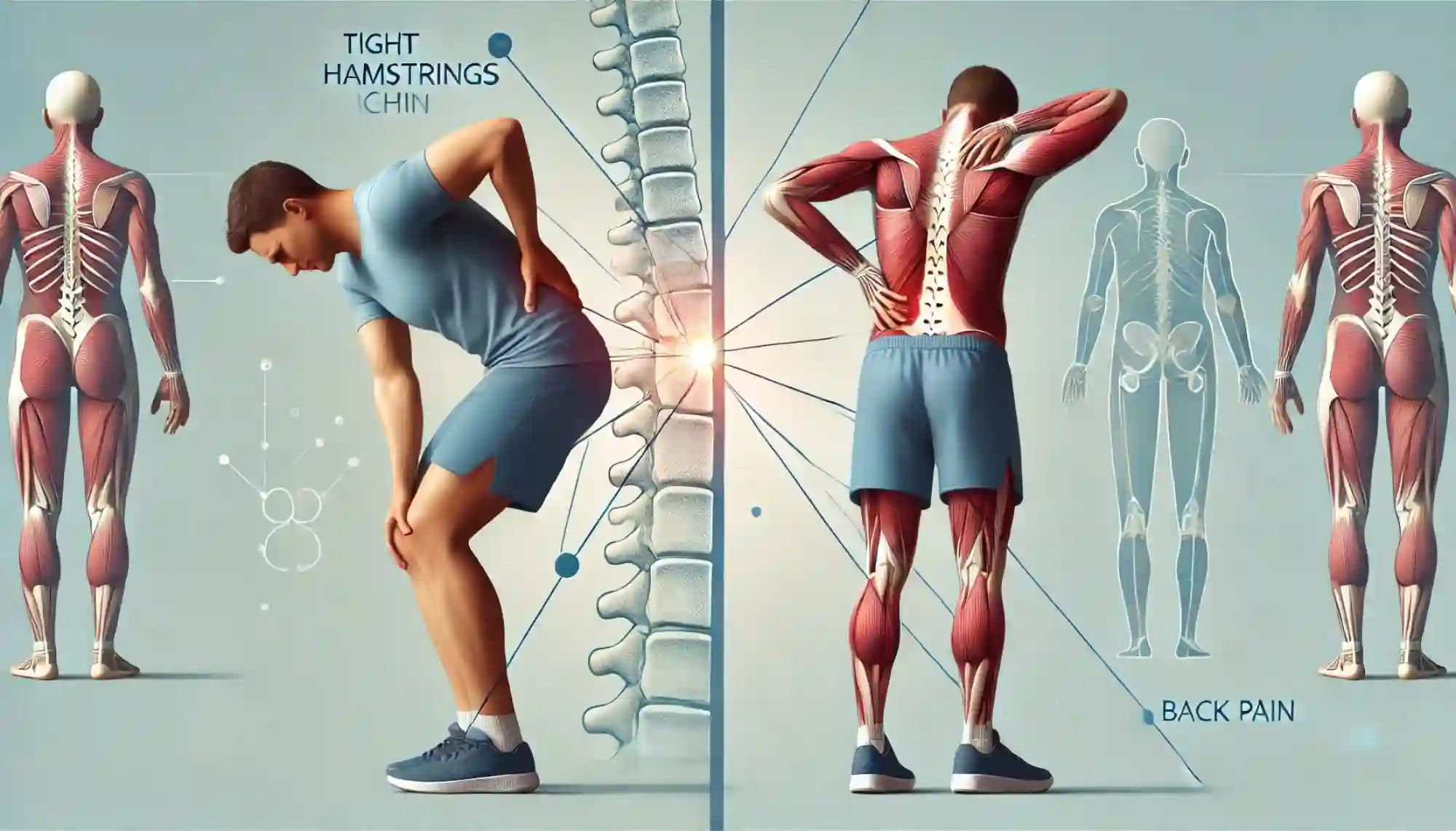Skinny to Muscular
Can tight hamstrings cause back pain? Ultimate Guide

Introduction
Back pain is a common problem that most people face at some point in their lives. It can vary from minor discomfort to unbearable pain and discomfort, affecting our daily routine and quality of life. But can tight hamstrings cause back pain? The short answer is yes, and that’s what will be discussed in the article. This article explores cases in which hamstrings can be tight, what the relationship between tight hamstrings and the lower back is, whether age matters, who is more at risk for this pain – men or women, how you can prevent it, what fitness experts think, when you need to see a doctor, the level of pain, and if you need surgery in the worst-case scenario.
Finally, some stories from readers who have experienced improvement from this pain will be told. So let’s see the answer to the question “Can tight hamstrings cause back pain?” When Are Your Hamstrings Likely to Be Tight? To answer the question “Can tight hamstrings cause back pain,” we need to know
When are Our Hamstrings more Likely to be Tight?
The hamstrings are a group of three muscles on the back of the thigh. They are essential for a variety of movements, such as walking, running, and bending of the knee. However, several factors can lead to the first question.
- Sedentary Lifestyle
When You Sit Long Hours continuously Whether at Work or At Home: One of the leading causes of tight hamstrings is a sedentary lifestyle. When you sit all the time, then your hamstrings are shortened. Over time, they became less flexible, this is why this term”can tight hamstrings cause back pain? actually is in the field
- No Stretching:
If you forget to make flexibility work a part of your routine, then those hamstrings are going nowhere! If the stretch and strength of Athletes who focus only on strength training without adequate stretching may experience this, increasing the risk of back pain.
- Overuse
If you do high-intensity runs or cycling without proper warm-up and stretching your hamstrings might be tight as they are prone to over-exertion. It is very easy to misuse, and overuse of it can cause muscle stiffness which leads to back pain.
- Muscle Imbalances
Sometimes tight hamstrings can be caused by muscle imbalances in your body. If your quadriceps (the muscles at the front of your thigh) are stronger than your hamstrings, the latter may tighten up to compensate. This imbalance often answers the question: can tight hamstrings cause back pain?
- Age
With age, our muscles naturally lose a bit of their pliability which can lead to tightness. That leads to the next, how does age affect hamstrings and back pain relationship?
Why Tight Hamstrings Cause Lower Back Pain
Well, do tight hamstrings lead to back pain? To know the correlation, let us discuss how the muscles of our body interact. The hamstrings are joined into the pelvis, which is then connected to your lower back. Your hamstrings tug your pelvis backward when they are tight. Placing separate pillows under your head and behind the knees can cause your hips to flex (forward tilt) — which flattens out the natural curve in your lumbar spine, leading to lower back strain.
Think of it like your body is a system with several dozen moving parts. Unbalances in one part affect the other parts too In this example, if your hamstring muscles are really tight the alignment of the pelvis and probably the spine you caused can result in lower back pain. And it all sort of ends up being like a chain reaction where your tight hamstrings pull on your pelvis, which in turn strains your lower back and makes you feel uncomfortable. Hence, it’s easy to see that the reason why your hamstrings are a part of causing back pain in many situations.
Does Age Matter?
To be sure, age is a factor in hamstring tightness and back pain. As we age, some flexibility and elasticity of the muscles are lost. This can result in much tighter hamstrings and a greater risk of developing back pain.
These more supple muscles in younger everyone lets them move more without restraint by aches. The thing is, when we get older our muscles don’t stretch as far and it’s more likely that those hammies going to tighten up. That is the reason, as people get older they generally have more back pain due to hamstrings that are never stretched. Can Tight Hamstrings Cause Back Pain as You Age?
Men vs Women — But Who Has It Worse?
Whether men or women are more prone to tight hamstrings and the associated back pain that comes with them has spurred some debate. The findings are quite mixed in the studies, but nonetheless they have some curious results.
A study by the American Council on Exercise (ACE), found that men tend to have tighter hamstrings than women. In part, this results from variations in muscle structure and flexibility. Women, in general, are born with flexible hamstrings and it is this advantage that decreases chances of the hamstring tightening up leading to back pain. But that does not mean women occupy a free zone from this trouble. For both men and women, factors such as lifestyle, level of physical activity and age have a major influence. However, can hamstring be tightening that causes back pain in men and women too? Well, sort of yes for men MORE than women.
Can tight hamstrings cause back pain: Prevention Tips
If you’re asking yourself the question “can tight hamstrings cause back pain” and are concerned, there is an upside: it’s preventable! Avoid tight hamstrings/ resulting back pain by routine exercise, proper stretching & great body mechanics. So in order to keep your hamstrings lome and back free, here are some of the things you can do.
- Regular Stretches
Stretch out your hamstrings daily Stretch: Stretching is a powerful way to keep your hamstrings long and supple, which in turn can help prevent the muscles from tightening up.
- Stable Core:
A powerful core will help take the tension off your back and help with alignment. Integrate core-toning work into your regimen, for example planks (elbow and side), as well as bridges.
- Do Not Sit For Long Hours:
Setting a reminder to stand, stretch and walk around for a minute every hour of your desk job. It stops your hamstrings from getting too tight after extended periods of sitting.
- Stretch and warm up:
Before you do anything active, stretch lightly to ease the muscles into action. This prevents the muscles from getting cramped and in turn, reduces injuries which means that you will not end up with back pain because of tight hamstrings.
- Sit Straight and Stand Tall:
Your sitting or standing posture is essential. It can decrease the load on your hamstrings and lower back when you are in proper alignment.
What Do Fitness Gurus Say?
Do tight hamstrings cause lower back pain? Basically, any fitness expert agrees that it is important to maintain good hamstring flexibility if you want your lower back pain not pleasant. The hamstrings are the nick at night of flexibility in your body …. ~Jill Miller says~ This is crucial in keeping them loose and strong as part of your whole body balance, to avoid lower back pain.
And the often-emulated celebrity trainer Harley Pasternak agrees: A mix is key, he says. You are looking for both strong and flexible muscles. Stretching is important since overly tight hamstrings can exert a pull on your lower back leading to pain,” he recommends. The above expert opinions also show that untreated tight hamstrings are a reason why you get back pain
Should I Go For a Checkup?
If you have chronic low back pain and think the tightness of your hamstrings causes lower back then visit a healthcare expert immediately. They evaluate your condition, eliminate other possible sources of lower back pain and advise you about appropriate therapy.
To let it pass is for the pain to increase and other, more severe complications are expressed later down the road. If you feel a niggle, see your doctor or physical therapist who can provide an exercise and stretching program specifically for you to help rectify the problem before discomfort sets in. Early intervention is best; the issue commonly leads to low back pain and can greatly impact your life.
Pain Levels: When Surgery Is the Right Option
It could be mild and only come one day, but sometimes the person suffering from bad pain has frequent attacks of severe to their daily lives. Different Stages of Pain You May Experience
- Aching: Typically a dull pain that can come and go. It may not warrant interrupting your daily activities but could be a pain.
- Moderate Pain: This type of pain can make difficult some activities like bending or lifting. You may have to rest more often and take breaks.
- Severe Pain — Severe pain may be disabling. This means that there will be restrictions on how much you can move, sit, or stand for prolonged periods of time. When it reaches this point, you need to go for professional opinions.
- Chronic pain: Pain that lasts for several to many weeks is known as chronic. Unmanaged chronic pain can affect your quality of life and also needs to be seen by a larger intervention.
If you have severe or chronic back pain, conservative treatments such as stretch exercises, therapy sessions or medication do not help relieve the symptoms of your condition. But remember that surgery is typically the last thing you try. The bulk of cases involving back pain caused by tight hamstrings can be handled via conservative treatments. However, keep in mind that when acute back pain is discharged after melting hamstrings, it’s worth weighing all the options.
Real-life Cases and Experiences
In fact, we can also read some experiences of people who experienced tight hamstrings and back pain in real life but recovered completely from their injuries.
- John: John is a 45-year-old office worker who suffers from low back pain because of chronic tight hamstrings. The nature of his job was such that he had to sit for long hours, which exacerbated the problem. John began to stretch his hamstrings and work on core strength daily after getting advice from a physical therapist. In a matter of months, his lower back pain was relieved by about 70%, and then he was able to live normally again. In his case, he is a classic example of how tight hamstrings lead to back pain and how taking good care of them heals that same pain.
- Sarah: An example of what Sarah experienced as a 30-year-old Runner – Was Overtraining But Not Stretching ==> Tight Hamstrings. That resulted in back ache which stymied her operating profession. She searched for a personal trainer to help her and this person encouraged doing strength-based workouts with flexibility being important. Sarah incorporated regular hamstring stretches and yoga into her recovery routine, which relieved the pain in Sarah’s right foot from 3 years prior allowing her to maintain running without any discomfort. We can see in Sarah’s case that it is possible to manage the impacts of a tight hamstring on back pain or leg stiffness with good mindfulness.
- Michael: 60-year-old retiree Michael had been living with chronic back pain due to tight hamstrings and bad posture. He tried several treatments but none brought relief. Eventually, he went to see a chiropractor who implemented an extensive program combining manual corrections with precise exercises and postural changes. This pain continued to improve over the follow-up years and Michael got back his range. This recovery proves that even persistent problems that at a basic level are due to a tight, hamstring can lead to back pain if left too long
Prevent Tight Hamstrings and Back Pain with These Exercises
The main target of regular exercise is to keep away tight hamstrings and reduce the back pain caused by that. One of the things that will help you a LOT is if you are doing some exercises in your routine. You can do a few of these exercises:
- Hamstring stretches: Seated forward bend and standing hamstring stretches are simple ways to keep the hamstrings flexible, which can decrease your risk for back pain from tight hamstrings.
- The Leg Curls: The direct hamstring exercise. You can do it by using a resistance band or the leg curl machine at your gym. This teaches your body to stay in balance, and can help you rid of those hamstrings before they decide to get tight.
- Yoga: Yoga poses that involve stretching the body like downward dog and forward fold are great for lengthening your hamstring muscles in addition to flexibility. Yoga also strengthens your core, which helps support your lower back and reduces the likelihood that tight hamstrings lead to low-back pain. There are some yoga flexibility exercises, with different movements that involves not only your whole back as well your whole body stretching options.
- Hamstring, Foam Rolling: Using a foam roller on your hamstrings targets muscle tightness and flexibility. Excellent for loosening up muscle knots and tension that can often cause tightness in the body
- Dynamic Warm-Ups: Adding dynamic stretches such as leg swings and high knees to your routine for warming up is an excellent way of loosening the hamstrings, and prepping them for exercise. It reduces the chances of injury and tightness that may harm you to ensure your hamstrings do not cause back pain.
- Glute Bridges: Building stronger glutes through exercises like the glute bridge can help balance strength between your hamstrings and contribute towards lower chances of hamstring tightness.
Hamstring Flexibility: The Way to Anyons…
One key piece of information you need to know is if flexibility with your hamstrings has led them to be tight and in return then cause stress-related back pain. You can check your hamstring flexibility quite easily using this very simple method:
- Sit-and-Reach Test: This classic test where you sit on the floor with your legs straight out in front of you and reach towards your toes. The typical rule of thumb is that if you can grab up to your toes or somewhat farther, then you have pretty good flexibility in hamstrings. It is just tight hamstrings! You can not even touch your toes. Having tight hamstrings may, then result in back pain for you.
- Forward Bend Test: Stand with feet hip-width apart and try reaching down to touch your toes. You have the flexibility in your hamstrings to touch your toes without bending at the knees You may have tight hamstrings if you feel a pulling sensation or discomfort in the back of your legs.
The goal of monitoring your own hamstring flexibility range is to pick up on possible tightness early so that you can intervene with appropriate stretching or exercises before the issue escalates. This method helps you avoid the case how can tight hamstrings cause back pain as it is very common.
Some Exercises Available To Stretch Your Hamstrings
It is important in maintaining the length of the hamstrings and preventing from having back pain. Some most common and effective hamstring stretches you can do are:-
- Standing Hamstring Stretch: Stand with one foot ahead of the other. Get the front leg as straight as possible and lean forward from the waist. Repeat this stretch 3 to 5 times holding for 20-30 seconds on each leg. This is a great way to help prevent lower back pain caused by tight hamstrings.
- Seated hamstring stretch: Sit on the floor with both legs straight out in front. Think of reaching forward with both hands towards your toes while keeping a straight back. Hold for 20-30 seconds. This stretch will help to avoid/back and back pain due to tight hamstrings.
- Lying Hamstring Stretch with a Strap: lying on your back and extending one leg down onto the floor. Wrap a strap or towel around your other leg, and lift the straightened one as you gently pull it towards you. Repeat for 20-30 seconds per leg.
- Wall Hamstring Stretch — Lay flat on your back and push the selected leg up against a wall in an L fashion. Slide your hips all the way to the wall, making sure that you can completely straighten your legs. Finally, this is a passive stretch that uses gravity and can be done anytime we sit down making it an easy way to make sure our hamstrings stay loose. This hamstring stretch will help to ensure tight hamstrings do not contribute to back pain.
Tight Hamstrings Cause Upper Back Pain?
Static hamstrings lead to lower back pain which can work its way up the spine and cause upper back problems, albeit indirectly. Here’s how:
Tight hamstrings can propagate through your body alignment so when they are tight, other impacts on the rest of their system cannot be ruled out. Hamstrings: Short hamstrings will pull on your pelvis, changing the way that gravity loads on your spine. This difference can travel up your spine causing bad postures and anti-postures in upper back muscles.
What is worse, you can even change your posture or movements without realizing that to avoid lower back pain due to tight hamstrings. This compensatory behavior puts more pressure on your upper back and shoulders, which is why this will likely cause pain here as well. Therefore If the hamstring is tight, will reflect pain all through overlapping parts of your back including suffering right from the lower to upper spine.
Conclusion
Can tight hamstrings cause back pain? The most straightforward answer: They absolutely can. It could be the result of a lot of sitting, not enough stretching, or just general aging, but your tight hamstrings can harm your pelvis and cause lower back pain. The good news is that by keeping up a consistent stretching and posture program, together with the right kind of training gym routine/exercise workouts – you can stop or alleviate much of this pain. If you are in pain that is not going away, please go see a professional. After all, he adds, taking care of your body today can help you avoid major problems in the decade or so to come.

Ahmad Hassan is a fitness writer and transformation coach behind GymWithMind.com, specializing in the Skinny to Muscular Transformation niche. After going from 51 kg to 65 kg naturally, he now shares science-backed, practical strategies to help skinny guys build lean muscle through smart training, balanced nutrition, and consistency. His guides blend real experience with research to make fitness simple, achievable, and sustainable

 Skinny to Muscular1 year ago
Skinny to Muscular1 year agoDiscover Elite Body Sculpting: Best 8 Method Revealed For Precision Shaping:

 Skinny to Muscular1 year ago
Skinny to Muscular1 year agoRealistic 6 Month Body Transformation Female: From Struggle To Power

 Skinny to Muscular1 year ago
Skinny to Muscular1 year agoBody Fitness Tips For Female; Unleashing Fitness Secrets

 Skinny to Muscular2 years ago
Skinny to Muscular2 years agoHow To Lose 50 Pounds in 5 Months: Is it possible ?

 Skinny to Muscular1 year ago
Skinny to Muscular1 year ago9 Best Front Squat Alternative At Home And Gym:

 Skinny to Muscular2 years ago
Skinny to Muscular2 years agoTop 12 Books For Strength Coaches:

 Skinny to Muscular2 years ago
Skinny to Muscular2 years ago15 Best Strength And Conditioning Books

 Skinny to Muscular2 years ago
Skinny to Muscular2 years agoKettlebell Golf Workout;- Get Ready For Swing
